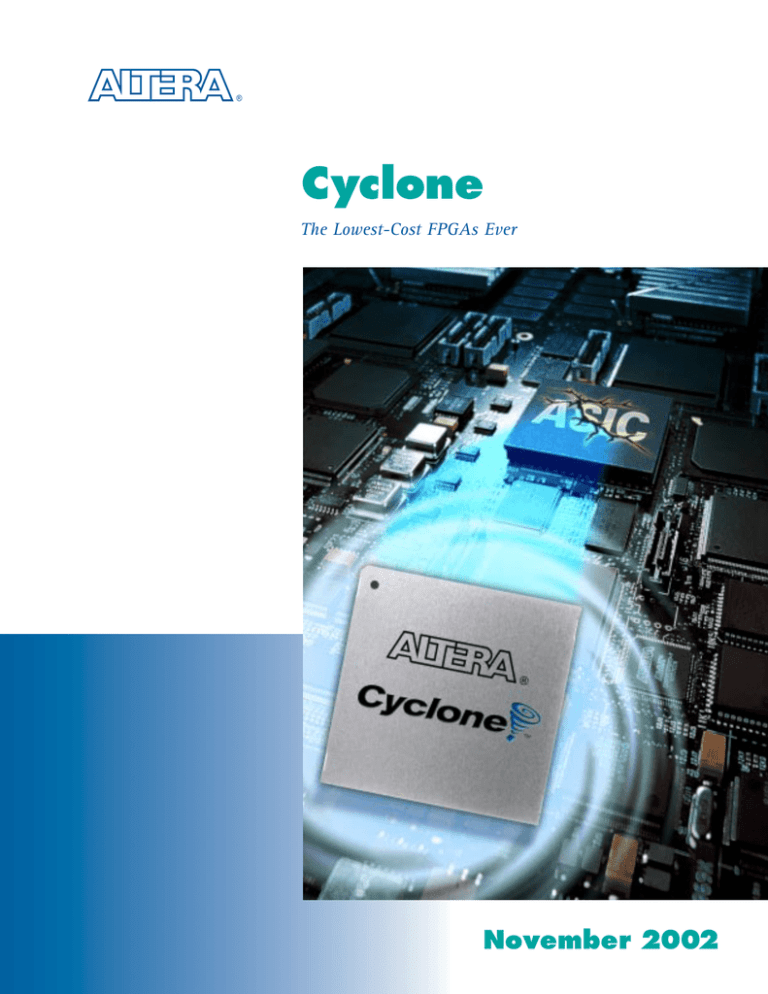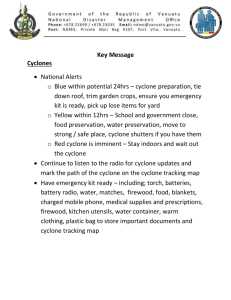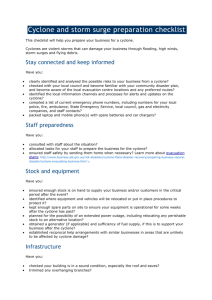
®
Cyclone
The Lowest-Cost FPGAs Ever
November 2002
The Cyclone Device Family:
Low Cost by Design
The New ASIC
Alternative
Introducing Altera’s new
Cyclone™ device family, the
lowest-cost FPGAs ever.
Designed to make the benefits of programmable logic more
accessible to a broader range of markets, Altera developed
Cyclone devices specifically for high-volume applications
that previously were driven by cost pressures to standard
products or ASICs.
The increasing complexity of
ASIC design is a major barrier
for customers who need to
get a competitive product
to market quickly. Without
clear visibility into end-market
demand, companies are finding it more difficult to
justify the costly up-front non-recurring engineering (NRE)
charges required for ASIC development. Consequently,
system designers have been searching for a risk-free
alternative that will get their products to market in less
time with less up-front investment.
The Cyclone device family has the perfect mix of features,
density, and performance as low as US $1.50 per 1,000
logic elements (LEs)—half the cost of competing FPGAs.
To achieve this, Altera brought existing and potential
customers into the product-definition process, to identify the
threshold price points, key features, and performance
required to make FPGAs viable in high-volume systems.
Finally, system designers building high-volume applications
in the consumer, communications, computer peripheral,
automotive, and industrial markets have access to the
flexibility, economic efficiencies, and time-to-market
advantages of programmable logic. You can learn more
about the Cyclone device family on-line at
www.altera.com/cyclone.
Cyclone devices—at ASIC prices—have arrived to put
programmable logic in the hands of volume-driven system
designers. Combined with the inherent value of FPGAs—
off-the-shelf, customizable products that require no up-front
costs and no minimum order quantities (MOQs)—designers
now have a programmable and scalable option for their
high-volume, low-cost requirements.
Packed with logic resources and features (summarized in
Table 1) unmatched by any other low-cost FPGA, Cyclone
devices are well equipped to integrate many complex,
system-level functions.
Table 1. Cyclone Device Highlights
Feature
Benefit
Embedded Memory
The Cyclone embedded memory structure consists of columns of 4,608-bit memory blocks. Each memory block supports
multiple configurations, including true dual-port and single-port RAM, ROM, and first-in first-out (FIFO) buffers.
External Memory
Interfaces
Cyclone devices have dedicated interfaces to support high-speed memory devices including 133-MHz (266-Mbps)
double data rate (DDR) SDRAM and fast cycle RAM (FCRAM) devices. The devices also support single data rate (SDR)
SDRAM interfacing.
I/O Standard Support
Single-ended I/O standard support includes LVTTL, LVCMOS, PCI, SSTL-2, and SSTL-3. For differential signaling requirements, Cyclone devices have up to 129 LVDS-compatible I/O pins that are capable of data transfer at up to 311 Mbps.
Clock Management
Circuitry
Eight low-skew, global clock networks span the entire device, fed by four dedicated input clock pins. Phase-locked
loops (PLLs), each with three output taps, feature frequency synthesis and phase-shifting capabilities for complete
system clock management on- and off-chip.
Nios® Embedded
Processor
The industry’s most widely used embedded soft-core processor can be configured to suit the specific requirements of
low-cost, Cyclone device-based designs. Each Nios processor consumes minimal logic, leaving plenty of resources for
other system functions.
Intellectual Property
(IP)
Accelerate system design with IP functions that are developed, tested, and licensed by Altera and Altera Megafunction
Partners Program (AMPPSM) partners. Available functions include PCI, memory controllers, fast Fourier transforms
(FFTs), and more.
Serial Configuration
Devices
Altera’s new serial configuration device family is designed to deliver the lowest possible total-solution cost. These
devices can store configuration data while using remaining resources for general-purpose storage.
2
Altera Corporation
Table 2. Cyclone Family Overview
Feature
EP1C3
EP1C6
EP1C12
EP1C20
LEs
2,910
5,980
12,060
20,060
13
20
52
64
58K
90K
234K
288K
1
2
2
2
104
185
249
301
144-pin TQFP
240-pin PQFP
324-pin FBGA
240-pin plastic quad
flat pack (PQFP)
256-pin FBGA
400-pin FBGA
M4K RAM Blocks
Total RAM Bits
PLLs
Maximum User I/O Pins
Available Packages
100-pin thin quad
flat pack (TQFP)
144-pin TQFP
324-pin FBGA
256-pin FineLine BGA®
(FBGA)
Figure 1. Cyclone Device Target Applications
Consumer
Communications & Wireless
Automotive
■
Set-top box
■
Mid- to low-end router
■
Gateway controller
Computers &
Storage Devices
■
Factory automation
■
Plasma display
■
DSL router
■
Software radio receiver
■
Printer
■
Process control
■
HDTV
■
■
Storage server
■
Network test equipment
DVD player
Telematics/entertainment
controller
■
■
Broadband fixed wireless
customer premise(s)
equipment (CPE)
■
Wireless LAN access point
With more capabilities and resources than any other lowcost FPGA, Cyclone devices offer a targeted feature set
optimized for its low-cost architecture. The Cyclone FPGA
family consists of four members (shown in Table 2), all of
which are available in multiple packages for a variety of
system and price requirements.
Paving New Paths for FPGAs
Cyclone devices open non-traditional application spaces
for FPGAs in new and existing markets, including consumer,
communications, wireless, storage, automotive, and
industrial (see Figure 1). Cyclone devices enable companies
in these cost-driven markets to quickly introduce competitive
and innovative products.
device, a 32-bit, 50 Dhrystone MIPS RISC processor costs
less than US $2.00 (see Figure 2). Updates are quickly and
easily performed without incurring additional costs, staving
off obsolescence and extending usability beyond that of
many off-the-shelf microprocessors and microcontrollers.
Figure 2. Cost-Effective Nios Embedded Processor Solution
EP1C3T100 Device
Density: 2,910 LEs
Package: 100-Pin TQFP
1
Price: US $4.00
EP1C3T100
Available Programmable Logic
Nios Embedded Processor Solutions
The Nios embedded processor is a configurable RISC soft processor core that
enables processor-based applications in Cyclone devices.
A full-featured, performance-optimized Nios processor
with peripherals can be tailored for the specific requirements
of virtually any system. With a Nios processor in a Cyclone
Altera Corporation
Industrial
Less than
2
US $2.00
4K RAM
Notes:
1
2
UART
Ethernet Interface
Serial
Peripheral
Interface
Multiply Unit
Pricing for 250K units in 2004.
Nios processor and peripherals use about 1,400 LEs.
3
The Total Low-Cost Solution
To fully realize the value proposition of Cyclone devices
in your system-on-a-programmable-chip (SOPC) designs,
Altera has developed a new low-cost serial configuration
device family. To further reduce overall development costs,
Cyclone devices are fully supported in the free Quartus® II
Web Edition design software.
Low-Cost Configuration Devices
To complement the Cyclone device family, Altera also
introduces new serial configuration devices. These devices
are priced for volume applications at, on average, less than
10% the price of the corresponding Cyclone device. The
two types of serial configuration devices (1 Mbit and 4 Mbits)
are offered in a space-saving 8-pin small-outline integrated
circuit (SOIC) package, as shown in Table 3. To add even
more value, any unused memory in these devices can be
used for general-purpose storage; for example, to store
the software code for Nios embedded processors.
Development Tools
Take a Cyclone design from concept to
device configuration entirely within the
Quartus II Web Edition software, available
at no charge on the Altera web site at www.altera.com.
Additionally, Cyclone devices are also supported in Altera’s
flagship Quartus II software (version 2.1 service pack 1
and higher), the industry’s most comprehensive SOPC
design environment, offering a full suite of programmable
logic design and verification tools and seamless integration
with third-party EDA software. The Quartus II software
offers advanced block-based design capabilities with the
LogicLock™ design methodology and hardware
verification tools.
Contact Altera Today
The Cyclone device family is the ideal solution for your
volume-driven system designs. To learn more about the
Cyclone device family, visit the Altera web site today at
www.altera.com/cyclone.
Table 3. Serial Configuration Devices
Configuration Device
Capacity
Target Cyclone Devices
EPCS1
1 Mb
EP1C3, EP1C6
EPCS4
4 Mb
All Cyclone Devices
®
The Programmable Solutions Company ®
Altera Offices
Altera Corporation
101 Innovation Drive
San Jose, CA 95134
USA
Tel: (408) 544-7000
www.altera.com
Altera U.K., Ltd.
Holmers Farm Way
High Wycombe,
Buckinghamshire
HP12 4XF
United Kingdom
Tel: (44) 1 494 602 000
Altera Japan, Ltd.
Shinjuku i-Land Tower 32F
6-5-1, Nishi-Shinjuku
Shinjuku-ku, Tokyo 163-1332
Japan
Tel: (81) 3 3340 9480
www.altera.co.jp
Altera International, Ltd.
2102 Tower 6
The Gateway, Harbour City
9 Canton Road
Tsimshatsui, Kowloon
Hong Kong
Tel: (852) 2945-7000
Copyright © 2002 Altera Corporation. All rights reserved. Altera, The Programmable Solutions Company, the stylized Altera logo, specific device designations, and all other words and logos
that are identified as trademarks and/or service marks are, unless noted otherwise, the trademarks and service marks of Altera Corporation in the U.S. and other countries. All other trademarks
are the property of their respective owners and may be registered in certain jurisdictions. Altera products are protected under numerous U.S. and foreign patents and pending applications, mask
work rights, and copyrights.
GB-CYCLONE-2.0



